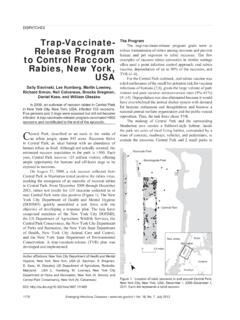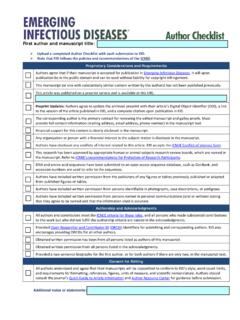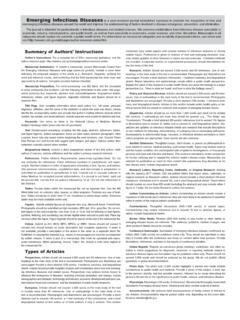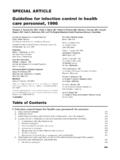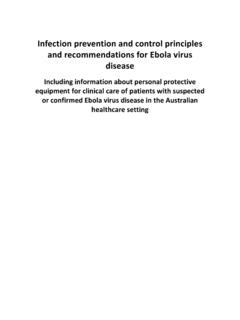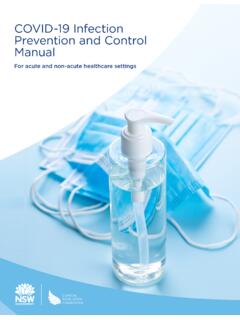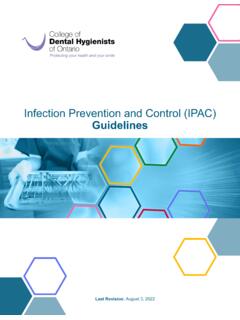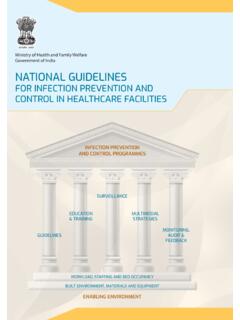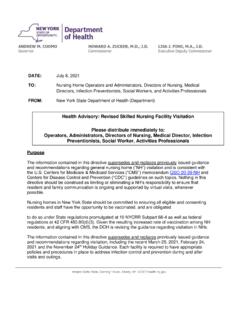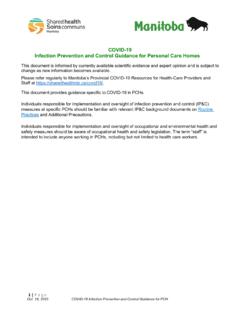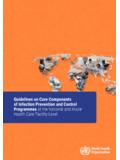Transcription of Infection Control in Home Care - Centers for Disease ...
1 208 Emerging Infectious DiseasesVol. 7, No. 2, March April 2001 Special IssueInfection Control in Home CareEmily RhinehartAIG Consultants, Inc., Atlanta, Georgia, USAA lthough home care has expanded in scope and intensity in the United States in the past decade, Infection surveillance, prevention , and Control efforts have lagged behind. Valid and reliable definitions andmethods for surveillance are needed. prevention and Control efforts are largely based upon acute-carepractices, many of which may be unnecessary, impractical, and expensive in a home setting. Infectiousdisease Control principles should form the basis of training home-care providers to assess Infection risk anddevelop prevention for correspondence: Emily Rhinehart, AIG Consultants, Inc.
2 ,1200 Abernathy Rd., NE, Suite 800, Atlanta, GA 30328, USA; fax: 770-399-4161; e-mail: to decrease length of hospital stay and shift care toambulatory settings, as well as patient and family preferenceto receive care at home, have contributed to the substantialgrowth of home care in the past decade. As life expectancy inthe population continues to increase and patients withchronic illnesses live longer, home care will continue care has also broadened in type and scope in thepast decade. Most patients are elderly and have chronicconditions requiring skilled nurses and aides. High-techhome care is provided to patients of all ages and may includehome infusion therapy, tracheotomy care and ventilatorsupport, dialysis, and other highly invasive procedures.
3 Inaddition, home-care nurses provide assessment, education,and support to post-acute-care patients who might have spentseveral additional days in the hospital but are now dischargedto cut costs. This category of patient may includepostoperative patients, postpartum mothers and theirnewborns, and patients with acute medical conditions such asnewly diagnosed diabetes and recent the United States, 9,655 agencies (1998 data) (1)provide home care to patients. Infection Control and health-care epidemiology have not kept up with the needs of thehome-care providers or their patients.
4 As this segmentcontinues to expand and services provided in the homeincrease, the Infection Control community must address therisks and needs of home Surveillance, prevention ,and Control in Home CareInfection surveillance, prevention , and Control haveconstituted a discipline that has been acute-care based andoriented for the past 40 years. However, as the health-caresystem continues to shift delivery of care from hospitals toother settings, surveillance, prevention , and Control programsmust respond. Since efforts to measure the incidence of home-care acquired infections , study the associated risk factors, andadapt prevention and Control measures for home care arenascent, available studies provide minimal information andlittle guidance.
5 A few articles have appeared in Overall, the literature is sparse, but expandingslowly (2-22).Systems of Surveillance:Definitions and MethodsWithout valid data on the incidence of home-careacquired Infection and analysis of risk factors, developingcontrol efforts is difficult. Thus, initial resources must bedirected toward developing measurement systems. Defini-tions and methods for the surveillance of nosocomial infectioncannot be readily applied to home care. First, definitions, suchas those developed by the Centers for Disease Control andPrevention s (CDC) National Nosocomial Infection Surveil-lance (NNIS) system (23), rely heavily on laboratory data,including cultures and serologic tests.
6 In home care, thediagnosis of Infection for clinical purposes is frequently madeon an empiric basis with substantial reliance upon physicalsigns and symptoms. In fact, physicians routinely rely on theassessment skills of home-care nurses and may not see apatient before making a presumptive diagnosis and writingprescriptions. The current reimbursement system does notsupport the use of cultures and laboratory tests used forhospitalized patients. For example, cultures are not routinelyobtained to diagnose or confirm infections of the urinary tract,respiratory tract, or wound or skin sites.
7 Cultures are morefrequently obtained to confirm and appropriately treatbloodstream Infection in patients undergoing home of home-care acquired Infection developed forsurveillance will need to rely more heavily on clinical signsand symptoms and tests that can be performed by the home-care nurse at the bedside ( , urine dipstick testing). Ascheme that includes probable home-care acquired Infection ( , clinical signs and symptoms of pneumonia) as well asdefinite home-care acquired Infection ( , confirmed by chestX ray and sputum culture) may be considered. Oncedeveloped, definitions must be examined for validity,sensitivity, and specificity.
8 However, methods to identifypatients at risk and apply the definitions are also methods routinely used in acute care, suchas cultures and other laboratory tests, are not practical inhome care (24) so other sources of information and methods ofscreening must be developed. In addition, a system that relieson a designated person(s) to review medical records andassess patients for Infection , such as Infection control209 Vol. 7, No. 2, March April 2001 Emerging Infectious DiseasesSpecial IssueTable. Criteria for inclusion in definitions of home-care-acquired infectionaSite of Infection Clinical data Laboratory dataCatheter-related UTIbChange in characteristics ofElevated serum leukocytes,urine, fever, painevidence of UTI in urinalysis,evidence of leukocytes in urinedipstick test, positive urine culture(>105 CFU of a single organismper mL urine)
9 Postoperative pneumoniaChange in character of sputum,Elevated serum leukocytes,decreased breath sounds,sputum Gram-stained smearincrease in rales and rhonchi,with evidence of respiratoryfever, shortness of breath, paininfection, positive sputum culture,positive chest X rayCatheter-related bloodstreamFever with chills and rigors,Elevated serum leukocytes, positive infectionredness, tenderness, or pain atblood culture, positive catheterinsertion site, purulent drainageculture (after catheter removal)at siteSkin and soft tissue infectionPain, swelling, tenderness at site,Gram-stain smear with leukocytesinflammation and warmth,and organisms, positive culture,purulent drainage, feverelevated serum leukocytesEndometritis in postpartumUterine tenderness and abdominalPositive Gram-stain smear ofpatientspain, purulent vaginal drainagelochia, positive culture of lochia, (lochia), foul-smelling lochia, feverremarkably elevated serumleukocytesaSource: Rhinehart E, Friedman M.
10 Infection Control in home care. Gaithersburg (MD): Aspen Publishing, Inc.;1999 (22).bUTI = urinary tract do in hospitals, is impractical in home carebecause of the logistics of patients, staff, and medical more suitable approach is a two-tiered system, whichrelies on home-care nurses to identify and report patientswith clinical signs and symptoms of Infection and on aninfection Control nurse to review evidence and ascribe adefinition (Table). Screening criteria for home-care nurseswould include fever, new antibiotic order, purulent drainagefrom a wound, change in color or odor of urine, change inconsistency or color of sputum, respiratory rales and rhonchi,and increased serum leukocytes.


